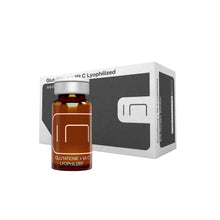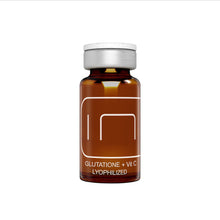
Anti-Oxidant Solution
Glutathione + Vit C Lyophilized is a revolutionary antioxidant cocktail that replicates the skin antioxidant network, keeps vitamin C stable in the skin and enhaces its properties. Glutathione and vitamin C act as networking antioxidants that can recycle each other from their radicalized forms back to their active, antioxidant forms. Through this process of mutual regeneration, networking antioxidants enhance and extend each other’s capacities, working within and around the mitochondria where most of the cellular oxidation occurs.
ANTI-OXIDANT SOLUTION
PHOTOAGEING PROCESS
Photoageing is the premature deterioration of the skin due to excessive exposure to ultraviolet light, and it manifests itself by the appearance of wrinkles and discolouration of the skin, either lightening or darkening, normally in the form of patches. As well as dryness which occurs as the most immediate indication, it also causes the appearance of wrinkles and crow’s feet, dilated or broken small blood vessels near the surface of the skin (telangiectasia), cutaneous atrophy, irregular thinning of the skin, elastosis (flaccidity), grooves, brown spots, also called liver spots or age spots, actinic keratosis (scaly patches with a high risk of turning into skin cancer) and actinic purpura (long-term alterations to the collagen in the skin). In normal conditions, the fibres of the dermis, the deepest layer of the skin, are arranged in an ordered manner and their function is to provide elasticity and resistance to the skin. In photo-aged skin this pattern is altered and the fibres appear fragmented, swollen and grouped in a disordered manner. This results in skin that is hyperpigmented, rough and dull with hyperkeratinisation, that is, with an accumulation of dead cells on the surface which slows down the process of cell renewal.
HYPERPIGMENTATION PROCESS
80% of the epidermis, the upper layer of the skin, is composed of keratinocytes, which are the cells responsible for the synthesis of keratin. This is also where the melanocytes are found, the cells responsible for the ynthesis of melanin, which protects against ultraviolet A radiation. In this way, the igmentation of the skin, caused by the excess production of melanin, is a defence mechanism to protect itself against the free radicals produced by solar radiation. But there are cases where this pigmentation becomes anarchic. There is excessive production and irregular distribution of the melanin which results in the appearance of hyperpigmented spots, which are benign but unsightly, such as melasma and lentigo. Melasma is an acquired hypermelanosisis which appears in areas exposed to the sun, particularly on the face, and is more common during pregnancy (25% of pregnant women). This is what is called chloasma or the mask of pregnancy, but it can also appear on women who use oral contraception (33% of women). Therefore, it is clearly linked to hormonal stimulation and, particularly, to the presence of oestrogens. Solar radiation is the direct cause. Lentigos, commonly referred to as age spots or liver spots, although they have nothing to do with this organ but are linked to exposure to the sun, are spots which over time tend to become darker due to the accumulation of ultraviolet radiation.









